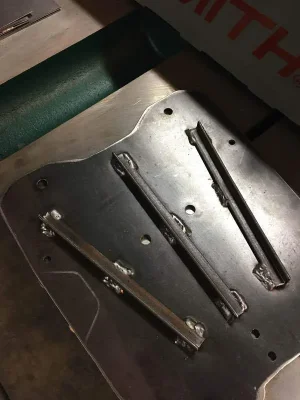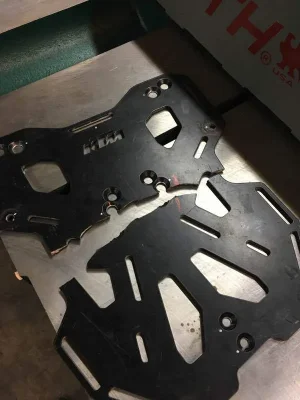I don't ride but a friend of mine is hard core and travels to Alaska and NWT on his bike. His rear luggage case mount broke (stress fracture). The design of it seemed flawed to both of us. In an effort to allow maximum flexibility for straps and other accessories (as well as reduce weight), all the mounting holes and cutouts reduced the metal at its key points, leaving a lot of the case over hanging the rear of the bike with lots of weight on it. Plus, the mounting holes line (sadly) up exactly with the stress points on the design, which is exactly where it broke. Duhh. Field testing should have caught this methinks.
This is the replacement mount I built. Original was 0.125, but some lower weight alloy that seemed not as magnetic as you'd think. It sure wasn't stainless. Replacement is 0.1875 A36 with angle iron reinforcement bracing. If you measure the cutouts WRT to the length, almost half the strength of the original plate is lost. Granted, our new design is heavier (6 lbs 1 oz vs. 3 lbs 8 oz), but we kept almost all the metal at key stress points.
If I had to do over, which I may, I'd modify my clamping procedure and welding order on the angle iron. I erroneously welded on the ends first which caused warping in the plate in excess of 0.125. Had I welded the centers first, some of this could have been avoided. I don't think it will effect the mounting enough to have to redo it, but I felt dumb for not thinking this through first.
On a related note, because I don't have a heavy knee mill like many of you, I can only countersink using a drill press or hand drill. Like others I can never get a smooth countersink this way. I've tried changing speeds, different flutes on the countersinks, light pressure vs high pressure, RapidTap vs no fluid, horizontal vs. vertical attack, etc. All result in a choppy/patterned countersink. So if anyone has other tips, please let me know.
This is the replacement mount I built. Original was 0.125, but some lower weight alloy that seemed not as magnetic as you'd think. It sure wasn't stainless. Replacement is 0.1875 A36 with angle iron reinforcement bracing. If you measure the cutouts WRT to the length, almost half the strength of the original plate is lost. Granted, our new design is heavier (6 lbs 1 oz vs. 3 lbs 8 oz), but we kept almost all the metal at key stress points.
If I had to do over, which I may, I'd modify my clamping procedure and welding order on the angle iron. I erroneously welded on the ends first which caused warping in the plate in excess of 0.125. Had I welded the centers first, some of this could have been avoided. I don't think it will effect the mounting enough to have to redo it, but I felt dumb for not thinking this through first.
On a related note, because I don't have a heavy knee mill like many of you, I can only countersink using a drill press or hand drill. Like others I can never get a smooth countersink this way. I've tried changing speeds, different flutes on the countersinks, light pressure vs high pressure, RapidTap vs no fluid, horizontal vs. vertical attack, etc. All result in a choppy/patterned countersink. So if anyone has other tips, please let me know.
Attachments
Last edited:




